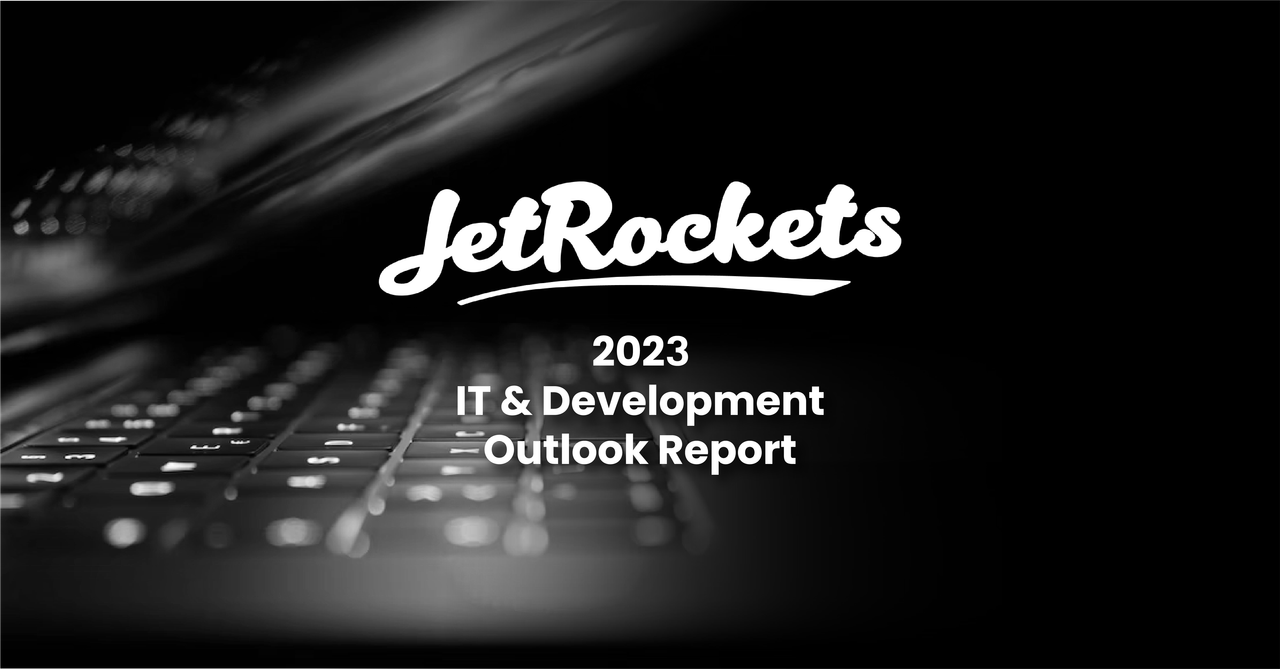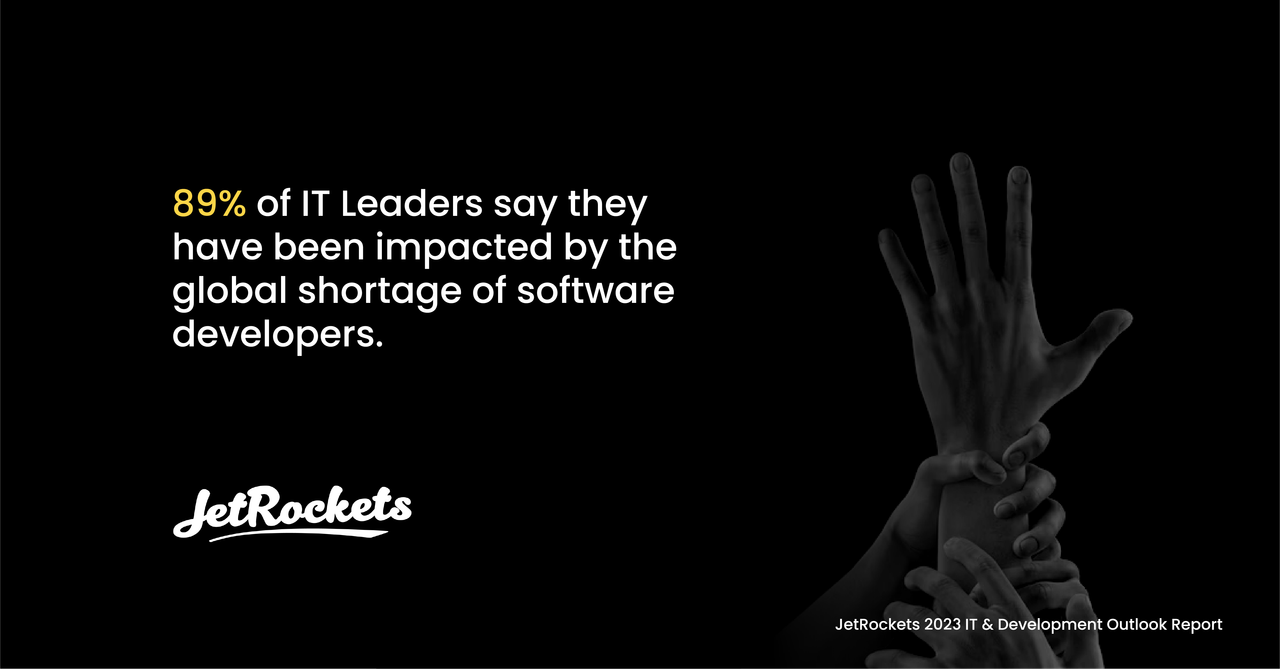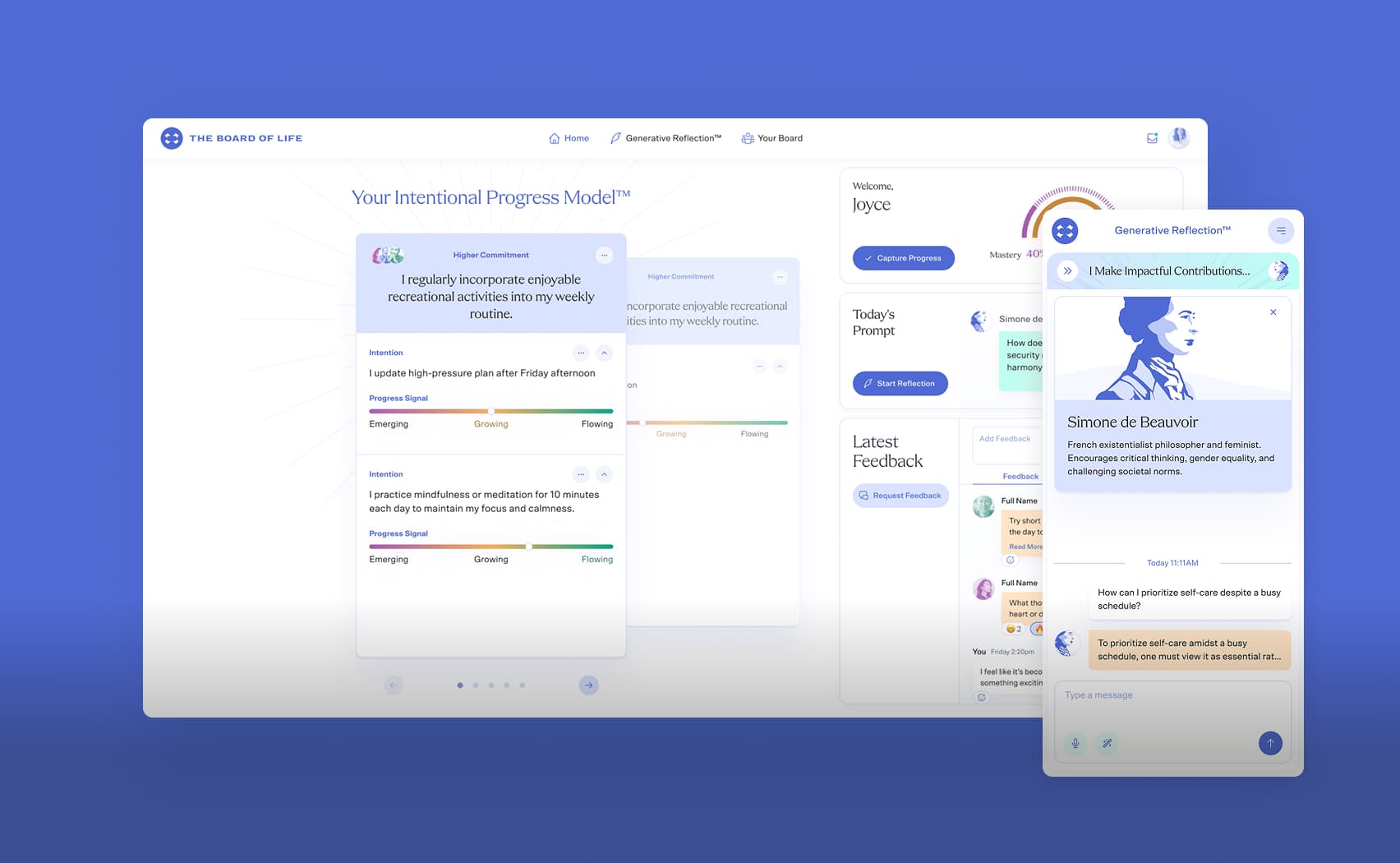2023 IT & Development Outlook Report
How Tech Leaders Are Tackling Digital Transformation Amidst Talent Shortages & Economic Uncertainty
While the entire C-suite has been tested over the last couple years, few roles have been impacted as much as the role of the CIO and CTO. Tasked with scaling their organizations’ digitization efforts, these tech leaders have been in the eye of the storm since the onset of the pandemic, with its fallout causing companies to grapple with the many challenges and complexities that have arisen since.

On the positive side, however, we’ve watched the roles of CIO and CTO elevate in the past few years from managing technology as a support function to driving strategy to fortify operations and adapt to new business and technological shifts. An evolution that has truly been imperative for every organizations’ survival.
But while this newfound spotlight has given them more prominence, it’s also ratcheted up the pressure on these IT leaders who are shouldering more responsibility as the race for strategic digitization intensifies. Further, new challenges, such as economic uncertainties and geopolitical tensions, have led to mass layoffs and resource constraints. These have created new obstacles and further complicated the role of leaders. The war in Ukraine, for instance, is proving to be a massive obstacle for those tech leaders who outsource to eastern Europe.
As a result, perhaps it’s not surprising that more than 1-in-3 tech leaders (39%) say they are either feeling“burnt out” (22%), or worried that they don’t have the resources and support needed to do their job (17%).

With all of this as a backdrop, the team at JetRockets, a leading software development agency for disruptive organizations, commissioned a study to more than 450 U.S.- based IT leaders in CIO and CTO roles to analyze the challenges they face amidst the digitization arms race, as well as the decisions they will be making in the coming months to keep their organizations on the road towards recovery.
The State of Development Post-Covid
Digital transformation is a challenging task in ordinary times. But the truth is, these times are far from ordinary. Indeed, CIOs and CTOs are facing enormous challenges as they continue to work to recover from the pandemic's impact on their organization.
70% of leaders say that their team’s productivity levels have not yet returned to pre-pandemic levels. With that in mind, it’s unsurprising that many CIOs and CTOs are mandating their teams to be back in the office full-time.
After all, tech leaders are under significant pressure to articulate quick answers and make decisions immediately. With the urgency of digitization soaring – which is a foundational piece of IT leaders' roles - this wide-reaching call for workers to return to the office is a sign that these leaders feel they need to run a tighter ship to steer their organization toward success. A ship that is smaller than it ever was.

89% of CIOs & CTOs say that they have been impacted by the global shortage of software developers, with nearly half (49%) saying they’ve been impacted “significantly”. Again, it’s important to note the impact that the war in eastern Europe is having here. For example, Russia’s invasion of Ukraine has forced tens of thousands of top software developers and tech leaders from both countries to flee. With Russia and Ukraine becoming hotbeds for tech talent in recent years and IT outsourcing powerhouses, it’s left an indelible mark on the lives of many young professionals trying to rebuild their careers amidst the war. Or, for talent stuck in Russia, they’ve been all but cut off from Western business, creating enormous challenges for organizations that have relied on it.
But staffing challenges in tech are not new. During the early stages of the pandemic, we also watched the mass exodus of talent from major tech hubs to areas that fit their lifestyles better. But for many CIOs and CTOs, the war in Ukraine adds complications they perhaps never imagined they’d have to deal with at any stage of their careers.
So how are tech leaders dealing with this? 60% say they are increasing salaries and benefits, and 56% say they are creating greater work flexibility. Nearly a third (30%) say they are reducing specific requirements from candidates such as degrees, certifications, and other credentials. While increasing salaries and benefits makes sense, thes last finding is undeniably worrisome. Forecasts suggest that a lack of IT skills worldwide, coupled with the resulting inability to solve business problems, will fuel a $390 billion loss each year by 2025. The fact that organizations are choosing to proliferate this skills gap by hiring underequipped talent to fill roles is less than ideal.
It is interesting to note, however, that 28% of CIOs and CTOs say they are now outsourcing their software and development needs. Just as the pandemic accelerated the freelance economy as organizations realized the value of tapping into an on-demand workforce, outsourcing software development has snowballed. In fact, according to data from Statista, the global IT outsourcing market already surpassed $92 billion this year with the software development outsourcing sector making a significant contribution to it.
Indeed, the ability to deploy a third party dev team when hiring complications or cost challenges prohibit you from building your own team from scratch is proving to be an alluring option. Just because talent shortages are making today’s IT leaders’ jobs much more difficult, doesn’t mean the need for high-performance software solutions has dwindled. In fact, more than 70% of organizations reporting that they are releasing code faster than they were pre-pandemic despite having fewer resources.
This illustrates the acceleration of digitization and the need for IT teams to find ways to do more with less. A need that has led to new development approaches.
Rise of Low-Code Vs. No-Code Increases Complexities
Low-Code and No-Code development allows individuals with limited or no coding experience to build limited functionality or simple apps and solutions for their organization. The rise of these citizen developers has increased as organizations look for ways to combat talent shortages and resource constraints. In fact, 63% of CIOs & CTOs say they are adopting low-code vs. no-code as much as possible, with the primary reasons being speed and affordability.

However, this requires us to ask the question: are we facing a situation of “Faster, better, cheaper — pick two”?
While certain use cases of Low-Code and No-Code can provide some business functions with more control over their tasks, workflows and speed time to market, these platforms generally lack flexibility and often require real development support to reach their full potential.
Moreover, in an age where security is of the utmost importance, turning over the development reigns of an entire organization to a team with minimal coding experience is certainly cause for concern. In fact, 77% of IT leaders say they worry about employees in their organizations without coding experience building applications with no-code solutions rather than with IT-approved technology.
Yet, as highlighted above, a vast majority are still prioritizing it.
To help combat these issues, every Low-Code or No-Code development project must include a built-in government and security strategy to restrict the chances of creating unsafe applications or code. Even more effective would be layering in the talents of a third-party development team, who can provide the coding, design, and engineering skills needed to ensure the security and efficacy of the software project. Many of these businesses offer additional support with efficient training and team-building services.
With market complexities requiring IT leaders to get more creative with their resources, the reality is that traditional means of developing software in-house is becoming far less common. And even though more CIOs and CTOs are turning to Low-Code and No-Code solutions, the fact remains that today’s leaders know that the best talent is needed to create the best solutions in a way that doesn't compromise the safety of their organization.
Still, innovation is likely to continue to evolve alongside the role of today’s developer, as evidenced by the fact that 63% of tech leaders say they are currently utilizing AI/ML for software testing, and an additional 26% say they are looking into it.
But in an environment where developers are increasingly forced to do more with less, these innovations should be seen as support, not replacements.
2023 Outlook on Key IT Themes
While CIOs and CTOs have no shortage of challenges on hand, we wanted to get a sense of the issues that lie ahead in 2023.
When asked what their biggest fear as it pertains to their role is, the top three responses were: ‘being victimized by a cyberattack or breach of some sort’ (33%); ‘budget constraints’ (30%); and a ‘severe drop in team productivity’ (22%).

With data breaches becoming much more commonplace, it’s not surprising that security is CIOs and CTOs number one concern. The reality is the shift to online has also expanded organizations’ attack surface, with cyber attackers garnering much more success targeting remote or hybrid businesses with weak security protocols. Moreover, as consumers and business customers raise their expectations for privacy, these bad actors know that they can demand much higher ransoms from businesses determined to save their reputations. Now, the average cost of a data breach is $4.62 million.
Meanwhile, when asked what biggest priorities/initiatives you are looking towards for 2023. The top 3 were ‘data security’, ‘hiring the right talent’ and ‘fiscal prudence’.

With pervasive macroeconomic uncertainty, it’s easy to understand why fiscal prudence would be at the top of tech leaders’ lists. And it only becomes more apparent when you consider that nearly 45% of tech leaders say that their organization is cutting their 2023 budget, with an additional 31% saying that while it hasn’t happened yet, they believe it will. Mid-sized businesses were the most likely (52%) to say with certainty that their organization would cut their 2023 budget. Meanwhile, small businesses were by far the most likely to say, “Not yet, but I believe they will.”
SMBs don’t have the same financial cushions as their larger counterparts and are, therefore, often forced to make difficult choices regarding their IT budgets. In fact, when these smaller businesses cut spending, many consider it to be a signal of a looming recession. Moreover, they’ve already been massively impacted by inflation. Small companies, for example, watched their profits drop by 4% in the last year despite growing their revenues by 87%. This is causing CIOs and CTOs within small and mid-sized businesses to be disproportionately impacted by budget constraints.
Today’s CIOs and CTOs have an enormous task on their hands. Aside from ushering in critical digital transformations that enable their organization to operate more efficiently and effectively, they are also being brought into areas that have become increasingly important boardroom discussions. This includes helping organizations stay on top of ESG and DEI efforts by leveraging digitization to provide transparency into these initiatives and to help track them. And while few question the importance of these initiatives, the truth is that this departure from traditional responsibilities isn’t making CIOs jobs easier.
In fact, 82% of tech leaders say they are worried that their organization's focus on Environmental, Social, Governance (ESG) and Diversity, Equality, and Inclusion (DEI) initiatives conflict with their ability to focus on other areas of digital transformation that are crucial to their overall productivity and performance.
The reality is, however, that in today’s landscape, these initiatives are critical to meet stakeholder needs. Moreover, the fact that we’re seeing an emergence of new software designed specifically to help organizations meet their ESG and DEI goals is evidence of the interconnectedness between these initiatives and companies’ digital transformations.
Even so, there’s one crucial point we haven’t mentioned yet. A statistic proves there’s still a pervasive representation gap in technology – especially in tech leadership. Just 24% of the CIOs and CTOs we surveyed for this report identified as female. This is a hard truth to hear, given there has been a lot of focus on boosting female representation in the C-suite. But the fact is, women still occupy less than a quarter of executive positions – suggesting organizations need to re-examine their DEI goals.

What Does This All Mean?
Tech leaders continue to face extraordinary pressure today as the need to digitize operations and create experiences for customers and employees that align with the widespread shifts that have taken place continue to increase.
And while their continued importance in the organization has presented unprecedented levels of opportunity, attaining it is only becoming harder in light of talent shortages, skills gaps and complexities brought on by new forms of development.
For these reasons, it’s unsurprising that we’ve started to see a shift in the way CIOs and CTOs are managing their organizations’ digital transformations. Furthermore, they’re having to get more creative with how they maintain productivity when market headwinds have made it incredibly difficult to do so.
A positive of this, however, has been the emergence of third-party development teams that’ve enabled IT leaders to leverage the skills of a dedicated product team without the pressure, cost restraints, and time constraints of managing them in-house. Not only is this giving them access to a larger pool of talent amidst the severe talent shortage, but we’ve already seen the time-to-market benefits with CIOs and CTOs admitting they’ve been able to release code faster this year.
After all, the tech world moves fast. It’s also growing increasingly competitive, giving organizations that are able to get to market early a significant advantage.
Study Methodology
A digital survey of more than 450 US-based individuals in CIO and CTO roles was conducted in October 2022.
Company Size:
1-50 employees: 14%
50-249 employees: 28%
250+ employees: 58%
Age:
18-29: 14%
30-44: 66%
45-60: 17%
60+: 3%
Gender:
Male: 26%
Female: 24%



